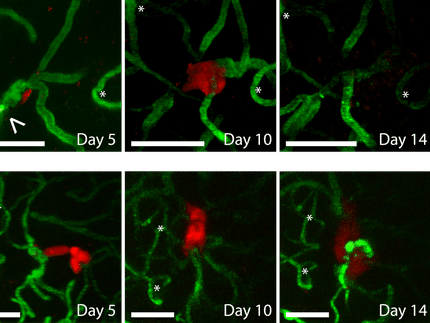Brain metastases in melanoma patients: important molecular mechanisms decoded
Different cell states determine progression of the disease
The development of brain metastases is a frequent occurrence in melanoma that is associated with a poor prognosis for the affected patients. The effectiveness of existing therapies varies greatly. The reasons for this variability, however, remain largely unknown. An international research team led by the University of Veterinary Medicine Vienna has now combined several analytical methods and was able to identify two molecularly distinct subgroups of melanoma brain metastases as an explanation for the differential response to therapies.

Symbolic image
Computer-generated image
Therapeutic interventions to treat melanoma brain metastases (MBMs) vary widely in their effect, which has a corresponding impact on the prognosis for individual patients. However, the mechanisms that govern therapy response are poorly understood. In an international study led by Vetmeduni, the researchers used an interdisciplinary combination of several analytical methods, including targeted gene sequencing (TargetSeq), to unravel, for the first time, the molecular programmes that may control the development of brain metastases.
Different cell states determine progression of the disease
The study’s last author, Torben Redmer from the Institute of Medical Biochemistry and the Institute of Pathology at Vetmeduni, summarises the main findings: “Our study provides evidence that MBMs can be divided into at least two subgroups. Important in this regard are molecular programmes regulated in connection with the expression of the adhesion protein E-cadherin (Ecad) and the nerve growth factor receptor (NGFR). While Ecad-associated programmes mainly occur in therapy-naïve MBMs, i.e. tumours that still respond to therapeutic measures, we find a high level of NGFR in treatment-resistant MBMs. The change in phenotype from Ecad to NGFR therefore probably determines the differential therapeutic response of tumours and potentially represents a major hallmark of progressive, i.e. rapidly progressing, MBMs.”
According to the researchers, further studies are now needed to fully explain the molecular programmes that drive the development and progression of single and multiple brain metastases in melanoma. The need for further research also applies to other cancers that have a high incidence of brain metastases, such as lung cancer and breast cancer.
Dangerous brain metastases – a frequent consequence of melanoma
The development of brain metastases is common in melanoma, lung and breast cancer. Despite great progress and a remarkable response in certain groups of patients, therapies developed so far are insufficient to achieve a long-lasting prevention of relapse and progression of the disease. The latter is determined by the emergence of multiple brain metastases and is therefore associated with a poor prognosis. MBMs develop in 20–40% of melanoma patients during the course of the disease. The median overall survival after detection of MBMs is only 8.9 months.
Original publication
Other news from the department science

Get the life science industry in your inbox
By submitting this form you agree that LUMITOS AG will send you the newsletter(s) selected above by email. Your data will not be passed on to third parties. Your data will be stored and processed in accordance with our data protection regulations. LUMITOS may contact you by email for the purpose of advertising or market and opinion surveys. You can revoke your consent at any time without giving reasons to LUMITOS AG, Ernst-Augustin-Str. 2, 12489 Berlin, Germany or by e-mail at revoke@lumitos.com with effect for the future. In addition, each email contains a link to unsubscribe from the corresponding newsletter.


















































